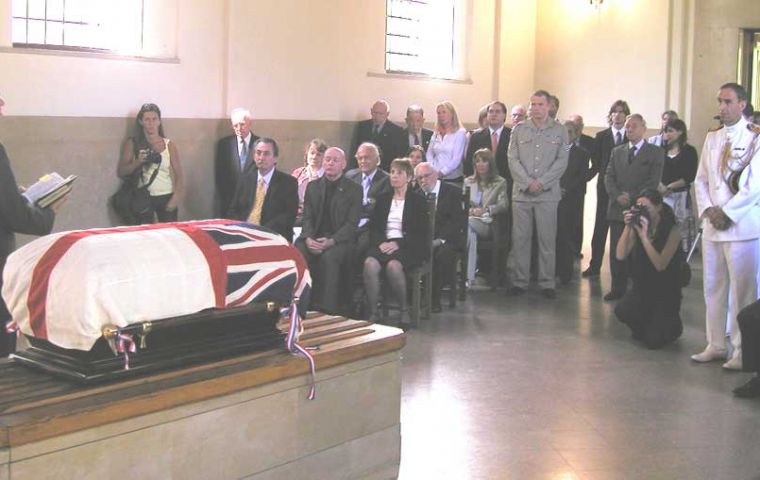MercoPress. South Atlantic News Agency
Unknown British Sailor Buried
 Rev. Kenneth Murray conducts service at the British cemetery chapel in Bs. Aires
Rev. Kenneth Murray conducts service at the British cemetery chapel in Bs. Aires An unknown British sailor has been buried with an Argentine Honour Guard breaking the gloom of British-Argentine relations for just a moment. The funeral took place last Friday in the British Cemetery, Buenos Aires.
The sailor came from the 14-gun corvette, HMS Swift, which sank in what is now Puerto Deseado in 1770. The Swiftwas on a patrol from Port Egmont in the Falkland Islands, and entered Puerto Deseado in a storm. It struck a rock and then beached itself. But as the tide went out the ship suddenly slipped back into the water drowning three members of the crew. One of the dead was found soon afterwards, but not the other two - both of whom were marines. The remains of one of these was found in the wreck after salvage work began in the 1980s. The two missing men were John Ballard and Robert Rusker. But it has not been possible to find out from the bones which of these two it was. Argentine and British Marine archaeologists began to salvage the wreck in 1983, and there is now a museum in Puerto Deseado of artefacts brought up from it. The unknown marine's coffin was covered by the White Ensign, and his remains were buried by the side of the British Legion Monument at the cemetery, alongside the graves of several other British servicemen, who had died in Argentina. The funeral was attended by British Ambassador, John Hughes, Defence Attaché, Captain Chris Hyldon, and Defence Coordinator, Sergeant Paul Treslove. The service was conducted in English, but with several Spanish prayers, at the cemetery chapel, by Presbyterian Minister the Rev. Kenneth Murray, who is Argentine of Scottish descent. Also present were local representatives of the British Legion, and Mr. Chris Underwood, from the Nautical Archaeological Society, Portsmouth. The Mayor of Puerto Deseado, Arturo Rodriguez, was there too; also the director of the museum there, Claudia Gutierrez, and the leader of the marine archaeologists, Dolores Elkin. Two wreaths were laid, one from the Municipality of Puerto Deseado, and one from the Instituto Nacional de Antropologia. The burial was followed by a reception at the Residence of the British Ambassador, John Hughes. Photographs of items recovered from the wreck were on display, and there was a projected presentation of the work of the nautical archaeologists in Puerto Deseado. Ambassador Hughes was presented with a book outlining the work, and made a short address. The funeral recalls the early days of British exploration in the area. Puerto Deseado derives its name from Port Desire, named by the British navigator Cavendish after his ship the Desire in 1586, during his first expedition. This took him around the World, making him the third man to do this after Magellan and Sir Francis Drake. During Cavendish's second expedition, his ship the Desirewas under the command of John Davis. Blown of course by a storm in 1592, Davis made the first recorded sighting of the Falklands - which is one of the reasons for the Falklands motto: "Desire the Right". Port Egmont, where the Swift was based when it was lost, is of course the basis for the British claim to the Falklands.By P.J.Pepper â€" Buenos Aires - Argentina




Top Comments
Disclaimer & comment rulesCommenting for this story is now closed.
If you have a Facebook account, become a fan and comment on our Facebook Page!